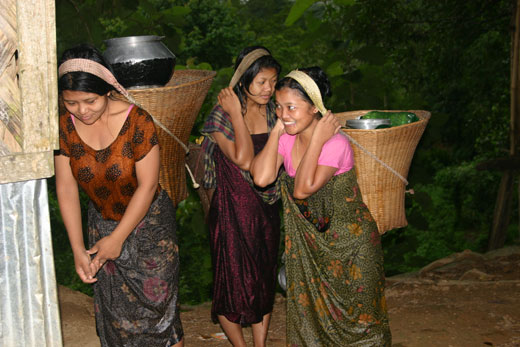Different ethnic groups of Bangladesh and
their colorful lifestyles have significantly enriched the entire culture of
Bangladesh. For centuries, Bangladesh has been the dwelling place of different
ethnic groups. In fact, 35 smaller groups of indigenous people covering about
two percent of the total population have been living in different pockets of
the hilly zones and some areas of the plane lands of the country. Their
historical background, economic activities, social structure, religious beliefs
and festivals make them distinctive. The beauty of the hilly zones as well as
the plain areas has been enhanced by the colorful culture and traditional
practices of different ethnic groups.
Murongs are one of the famous tribes of
aborigines of Arakan and two Murong Kings ruled Arakan in the tenth century AD.
Murong or Muren refers to an ethnic
Xianbei tribe who are a Mongolic people attested from the time of Tanshihuai.
Different strands of evidence exist linking the Murong to the Mongols. Murong
is also a Chinese surname. The Former Yan, Western Yan, Later Yan dynasties as
well as Tuyuhun were all founded by the Murong. The chieftain Murong was the
first ancestor of the Murong tribe, which was named after him. He was a
chieftain noble of the Middle Section during the
rule of Tanshihuai. Murongs live in Lama, Ruma, Alikadam and Thanchi upazilas near
Chimbuk Mountain of Bandarban district.
In 1991, the Murong population in Bangladesh
was 22,178 and constituted the fourth largest tribe in the Chittagong Hill
Tracts. Murongs are patriarchal. Sons inherit the property. They have different
clans and many sub-clans.
Murongs do not marry within the same clan or
sub-clan. Their boys and girls are also not allowed to marry within two
different clans involved in war even after they enter into a truce or peace agreement and become friends. Murongs have many different
ways of performing the marriage ceremony but the ceremony is usually very
short. Once a couple is ready for marriage, a cock is slaughtered in the
presence of the couple. When the blood gushes from the veins, someone dips the
middle finger and anoints the forehead of the bride and groom. Then follow the
declaration that the two are husband and wife. After this brief ceremony, the
bride and groom eat together and the invitees and guests sprinkle water and
rice to bless the couple.
Most Murongs are Buddhists and some are
Christian converts. In general, however, they are still animists and they
worship nature. They revere Thurai as the creator of this universe. All their
pujas are directed to Oreng, the God of the household and day-to-day business
affairs. They have many superstitions. They believe in signs and omens and
their immediate undertakings are affected by these beliefs. Sungteung is
another deity Murongs pay homage to, although this puja has little importance
in society. Before the harvest, the Murongs observe a puja called Kumlang, in
which they ceremonially kill a cow. The young men and women dance, sing, eat
and drink homemade beer during this ceremony.
The main profession of the Murongs is jhum
cultivation and lumbering wood from the jungle. Before jhum cultivation in the
month of Srabon they offer Oreng puja. The women work harder than the men. They
have a distinct language but no written script. The Xianbei are generally considered speakers of Mongolic
languages.
Murongs love songs and dances. They use
homemade musical instruments, which are made of bamboo. The flute is the
dominant instrument. Rice and homemade beer are their main food and drink. They
eat the tiger, dog, goat, pig, cow and many other animals. Their delicacy is
nappi, made of the fermented fat of fish, frog, deer or boar, mixed with fermented
rice.
Murong men wear length and women wear short
skirt. These are all locally made. Murongs build houses on platforms on
hilltops. Their houses are bigger than the houses of other tribes.
Murongs burn the bodies of the dead. Murong tribesmen do
not mourn when someone dies. This is because they believe that mourning will
hurt the soul of the deceased instead, they indulge in dances and songs and
make merry. They also exhibit the articles used by the deceased and keep these
beside the dead body because they believe that the deceased persons will use
these in the afterlife.


No comments:
Post a Comment